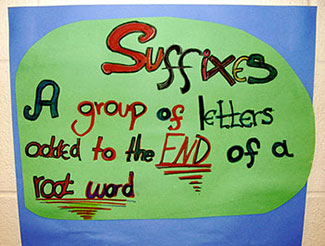
Source: 3, mrmayo, Flickr
Just as prefixes are added to the beginnings of words to change their meaning, suffixes are added to the ends for the same purpose. Some suffixes serve a grammatical function by telling you what kind of word you are dealing with: nouns, verbs, adjectives, or adverbs.
- The common suffix -s makes nouns plural (oyster, oysters).
- Another common suffix -ed makes verbs past tense (shell, shelled).
- Another common suffix -ly signals that a word is an adverb (slow, slowly).
- Two other common suffixes -er and -est signal degrees in adjectives (old, older, oldest).
 Use your notes to answer these two questions: What suffix would you add to the adjective clammy to compare one sticky handshake to another? If you experienced three clammy handshakes, what suffix would you add to the adjective clammy to identify the stickiest one? Then, check your understanding to see sample responses.
Use your notes to answer these two questions: What suffix would you add to the adjective clammy to compare one sticky handshake to another? If you experienced three clammy handshakes, what suffix would you add to the adjective clammy to identify the stickiest one? Then, check your understanding to see sample responses. Sample Responses:
Add the suffix -er to compare two handshakes: clammier.
Add the suffix -est to compare three (or more) handshakes: clammiest.

Source: Cory: Meaningless Life, Gino Carteciano, Flikr
The suffixes -er and -est don’t really alter the meaning of the original word clammy. Instead, they add information, enhance, or intensify the word. Prefixes and roots do the heavy lifting on meaning, yet some key suffixes also carry their share of the meaning weight. For instance -er or -or means “one who does or person connected to.” A wrestler is one who wrestles, a collector one who collects, and a writer one who writes. The suffix -er carries a double load by changing adjectives to their comparative form and by changing verbs into nouns.
Two other suffixes that change meaning are -ful meaning “full of” and -less meaning “without.” These suffixes are useful for creating antonyms (harm, harmless; care, careless). Watch as words with suffixes are used to describe an unusual industry.
Watch the video “suffixes.”
Source: suffixes, Australia Plus, YouTube
The suffixes -ment meaning “act of” and -ness meaning “state of” serve somewhat similar purposes. Both are used to create nouns. The suffix -ment is used to transform verbs into nouns, while -ness is used to transform adjectives into nouns. The verb move becomes the noun movement. The adjective vast becomes the noun vastness.
Decide whether each word below is a verb, a word that shows action, or an adjective, a word that describes. If it’s a verb, drag the root to the -ment box. If it’s an adjective, drag the root to the -ness box. Continue until you’ve moved each root to its noun-forming suffix.
